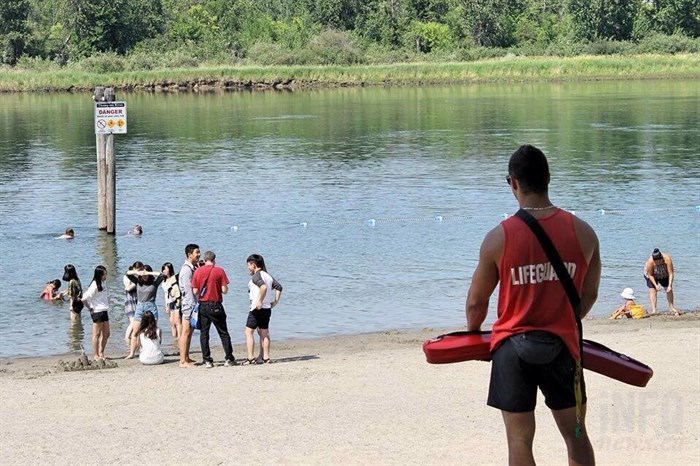
FILE PHOTO: Lifeguards had one of the highest rates of heat stress related claims in B.C. in 2016, according to WorkSafe B.C.
(GLYNN BROTHEN / iNFOnews.ca)
August 02, 2017 - 9:45 AM
OKANAGAN - With temperatures potentially soaring into the high thirties this week, WorkSafe B.C. is warning workers to be aware of the risks associated with the heat.
“Outdoor workers may face many risks when the weather is hot,” WorkSafe B.C. spokesperson Dan Strand says in a press release. “By law, employers are required to know if their workers are at risk by performing a heat-stress assessment and implementing a mitigation plan when necessary.”
When your body is unable to cool itself faster than your internal temperature rising, heat stress can occur, according to the release.
If left untreated, it can lead to heat stroke and other injuries from heat exhaustion, Strand says. Temperatures are forecast to reach 36 C in the Okanagan later this week.
Workers should also take steps to protect themselves from the wood smoke that occasionally darkens the skies.
In 2016, there were 16 accepted claims for work-related injuries caused by heat exhaustion and heat stroke, according to the release. In the Central Okanagan region, there were 17 accepted claims for heat stress-related injuries from 2007 to 2016.
Jobs with the highest number of heat stress related claims include lifeguards, motion-picture production assistants, truck and bus drivers, and recreation sport and fitness leaders, according to the release.
Symptoms of heat stress include dizziness, fainting, excess sweating and muscle cramps. Heat stroke symptoms include increased breathing rate, confusion, seizures, cessation of sweating and cardiac arrest.
Employers can prevent heat stroke for workers by:
-
Monitoring heat conditions and requiring workers not to work alone
-
Ensuring there is adequate first-aid coverage and emergency procedures in place
-
Make physical modifications to facilities, equipment, processes to reduce exposure
-
Changing work practices and policies to limit the risk
-
Determining appropriate work-rest cycles; when a worker feels ill it may be too late
-
Rotating work activities or using additional workers to reduce exposure
-
Establish cooling areas with shade and water
Workers can prevent heat stress by:
-
Drinking plenty of water (one glass every 20 minutes)
-
Wearing light-coloured, loose-fitting clothing made of breathable fabric such as cotton
-
Taking rest breaks in cool, well-ventilated areas
-
Doing the hardest physical work during the coolest parts of the day, before 11 a.m. and after 3 p.m.
-
Knowing your personal risk factors such as medications and any pre-existing conditions
-
Checking the signs and symptoms for yourself and co-workers
To contact a reporter for this story, email Jenna Hickman or call 250-808-0143 or email the editor. You can also submit photos, videos or news tips to the newsroom and be entered to win a monthly prize draw.
We welcome your comments and opinions on our stories but play nice. We won't censor or delete comments unless they contain off-topic statements or links, unnecessary vulgarity, false facts, spam or obviously fake profiles. If you have any concerns about what you see in comments, email the editor in the link above.
News from © iNFOnews, 2017